Caring for freshwater pufferfish is a complicated task for newbies. So, if you have a home aquarium and plan to adopt a puffer fish as your pet, you should get advice from an expert aquaculture specialist. Hence, we hope the following facts will be the best guideline to arrange tank size, water conditions, and the interiors of the tank as desired for the puffer fish species.
What is it Like to Keep Freshwater Puffer Fish?
Jump To
- 1 What is it Like to Keep Freshwater Puffer Fish?
- 2 Freshwater Puffers Behavior/Compatibility
- 3 Types of freshwater puffer fish
- 4 Tank Setup for Freshwater Puffer fish
- 5 Can you put 2 puffer fish together?
- 6 Who are the freshwater puffer fish tank mates?
- 7 How to plant and set up your aquarium for puffer fishes?
- 8 What to Feed Puffer Fish and the perfect frequency of feeds?
- 9 How big does a freshwater puffer fish get?
- 10 The lifespan of freshwater puffer fish?
- 11 Freshwater Puffers’ Breeding
- 12 Freshwater Puffer fish Common Illnesses
- 13 Where to buy Freshwater Puffers?
- 14 Conclusions!
It is fantastic even to think of keeping a freshwater pufferfish in your home aquarium. They are that much cute and add diversity as similar to the marine environment. Do you know there are more than 120 of identified pufferfish species in the world? But, you can not adopt all of those species inside the glassed aquariums.
So, you just have to select the most suitable ones as with the tank conditions and your potential to provide facilities. Further, it is really necessary to consider toxicities and how much they can adapt to a limited space before selecting the ideal pair for your place. It means you should see beyond the color and body structure of this rounded and puffed fishes. And, the different species have used to live in specific water conditions.
Thus, not all are freshwater pufferfish. Further, they will not be able to stay healthy in your small tank. Rather, they will need the marine environment to complete the cycle.
Freshwater Puffers Behavior/Compatibility
Even freshwater pufferfish seem cute. They have varying degrees of behavior inside a tank. So, the ball fishes are not ordinary in behavior, it is complicated to guess, and the patterns may vary from species to species. But, generally, pufferfishes move slowly. That is why we can see beautiful sightseeing of moving fins all over the tank. These slow moves are wonderful to see, and they will make your living room a paradise under the theme of marine life.
But, this feature itself can be a disadvantage for these fishes due to easy exposure for predators. However, as nature makes everything reasonable, they also have a protective mechanism. It is the ability to take air or water suddenly into the stomach and to turn for a ball-like structure. That is why they have got the name “ball fishes” or “balloon fishes”.
Once they turn into a ball, the tiny spines will get activated and erected. So, it can help them a lot to fight against their predators. Sometimes, it seems like aggressive behavior than a protective mechanism. Hence, do pufferfish are aggressive, and can they really attack the other fishes as food?
Yes! They can sometimes be aggressive for other fishes and predators. Occasionally, you will be able to note hostile characteristics towards their same gang or other partners. But, this is not the same for all species, and there are calm and peaceful species to adopt in your home aquarium with other non-aggressive fishes. If you could choose the best partners, aquaculture may be the most interesting hobby for you.
Types of freshwater puffer fish
As we highlighted earlier, there are more than a hundred and twenty species of balloon fish worldwide. But, not everyone could live in freshwater inside a home aquarium. Thus, you might be in doubt on what is the best type for commercial or domestic set up. So, we have lined up a few popular species which can live outside the pure marine environment. And, all these species have the capabilities to fulfill their lifespan in the same conditions. Wow! It is time to select what is the perfect matching freshwater fish pet for you.
Dwarf puffer / pea puffers (Carinotetraodon travancoricus)
These rounded small buddies are endemic to Indian aquaculture and can mostly be seen around the southwest area. So, they have three other names given by humans over the years as with the external appearance and behavior. Hence, you will hear more about these puffers, either as Pea puffer or Malabar puffers. And, sometimes, the pygmy puffers are also one of the common names used to introduce these ball fishes.
The pea puffer is easy to cultivate in a limited space as it is one of smaller-sized variety. The maximum length of the body will not exceed four centimeters on average. And, they will stay calm and peaceful with all other fishes. But, do not expect to have baby fishes as sooner. They have a bit complicated sexual behavior, and the dominant fish will gradually turn to a male. After, that only they start to release hormones that can attract the females.
If you are clever in close observation, you would identify this dominant Dwarf fish through the larger body size and brighter color. And, he will be the most beautiful puffer in your tank.
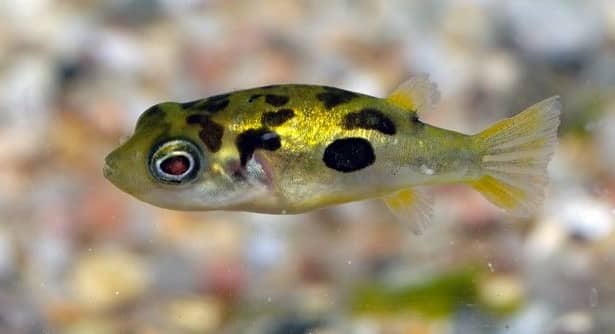
Red-tailed dwarf puffer (Carinotetraodon irrubesco)
Even the red-tailed are a bit larger species than the Dwarf pufferfishes, they also easily can adopt in a home aquarium. The maximum body size of these tiny comrades with beautiful reddish colored fins is around 4.4 in centimeters. And, even the name suggests they are beautiful enough to be proud about having a pair of fish, the creamy strips in brownish colored body structure don’t give them that much a rich look.
Yet, they can extremely be a part of diversity when there are other fish species in the aquarium. However, the commercial use and demand for these fishes are less when compared to other types in this family. Further, these tiny river fishes also have dominant sexual dimorphism. So, the strongest fish will turn into a male fish which can quickly identify through the color difference.
But, there may have a visible change in brightness other than a different color from the gang. The all the red tail fishes are also having red eyes by making their body structure unique among others. And, they live in acidic water with the biological connections of other smaller fish varieties such as rasboras and pipefishes.
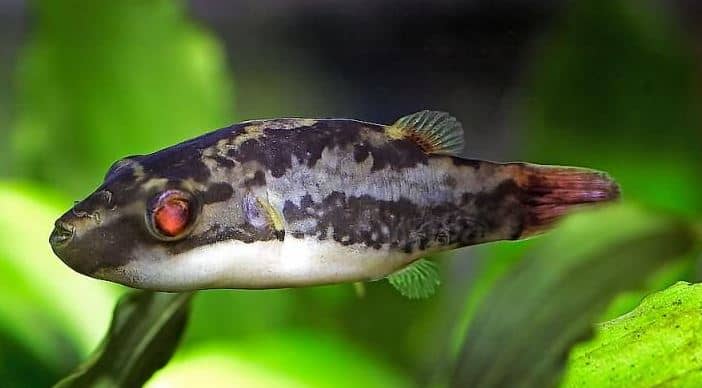
Crested puffer fish (Carinotetraodon lorteti)
Again, these puffers also have red eyes and their whole body also takes red colored by making a huge difference from red-tailed puffers. And, they are not pure freshwater or saltwater fishes. So, they often can be found in brackish water or in artificial water pathways such as canals. But, it says this is a very rare type. So, if you have one you can be proud of your aquarium. And, you also can try to breed them for commercial use.
However, since they grow a bit larger body size (often around 7 cm), you should be able to provide facilities for a larger gang when cultivating for commercial use.
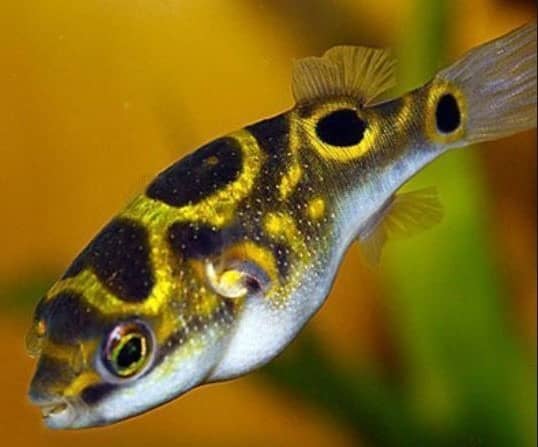
Fahaka Puffer (Tetraodon lineatus)
These yellowish-brown stripped Puffer fishes are beautiful in external appearance. So, they can easily be the factor for biodiversity in commercial aquariums. Yet, they have the ability to release toxins when getting aggressive.
Further, they may grow more than a foot when matured. And, when they get aggressive they will turn into a puffed ball which is size nearly 43 in centimeters. Thus, usually, these pufferfishes are not recommending for domestic aquariums and to cultivate with other fishes.
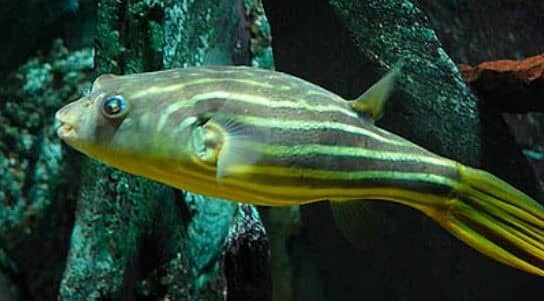
Imitator puffer (Carinotetraodon imitator)
Here also a species that is mostly found in freshwater. So, they do not desire to live in a marine environment. Thus, if you are expecting to cultivate the Imitator puffers, you should prepare a tank desire to the river ecosystem.
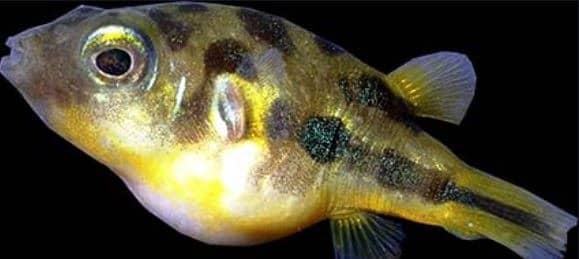
Golden puffer (Auriglobus modestus)
The ability to turn into a ball body shape and also to release the toxins are common for this species too. But, it has somewhat a different body shape from other types and the body color also takes golden brownish. So, they are brighter than others.
Since these golden puffers are smaller, arranging a tank may not be a challenge. Yet, as they can become aggressive with other fishes, you should care when selecting fishes for a home aquarium. However, they will live longer with you. There are reported cases with more than ten years of the life cycle for these golden avocado colored puffers. So, you could be able to share lots of life incidences with these cute pets.

South American puffer (Colomesus asellus)
These brownish and cross-stripped puffer fishes carry all the native characteristics of the puffer fish family. So, they also can inflate. And, they all bear toxins. Further, dimorphism is also a common characteristic of this type too.
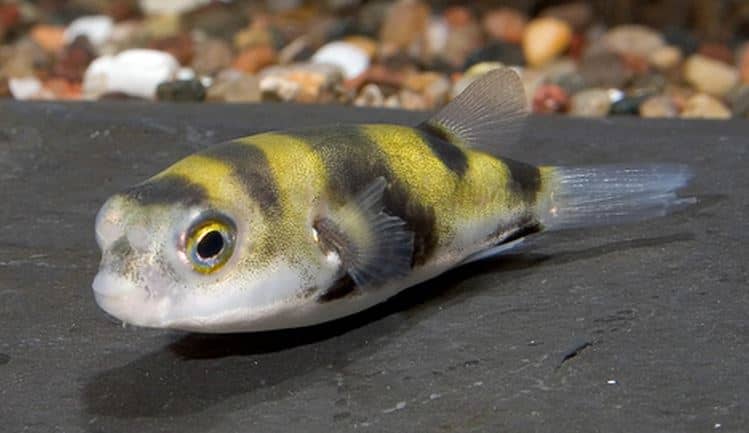
Congo puffer (Tetraodon miurus)
The Congos are easy to cultivate inside a tank. But, there should have specified characteristics in the tanks to make it more desired for this species. Actually, these puffers are a bit lazy and will not show moves other than for feeds and spawning when breeding. So, they usually used to be buried at the bottom of the tank. Hence, you should include a bit of heavy sand layer into the tanks when cultivating the Congos.
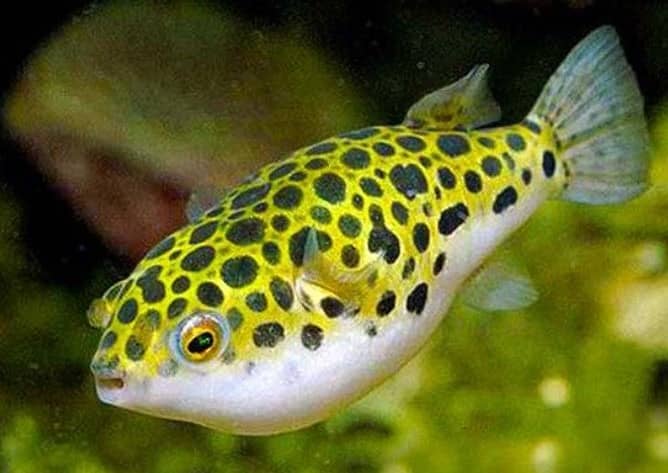
Mbu puffer (Tetraodon mbu)
As one of the largest species in the world, the Mbu puffers can grow up to sixty centimeters long. So, this type of puffers is not good for domestic aquariums.
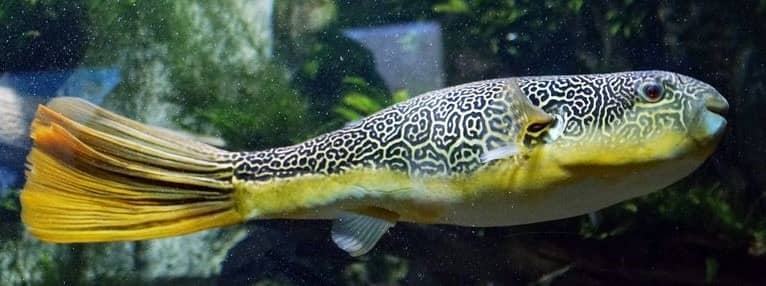
Tank Setup for Freshwater Puffer fish
The tank setups may have a bit of variety as with the species. So, we have highlighted some facts earlier under the types and their specification. Yet, as a family of fishes, they desire certain water conditions and the living space to live longer and healthier. Basically, since they are more vulnerable to diseases, the experts always suggest paying extra care when setting the living conditions.
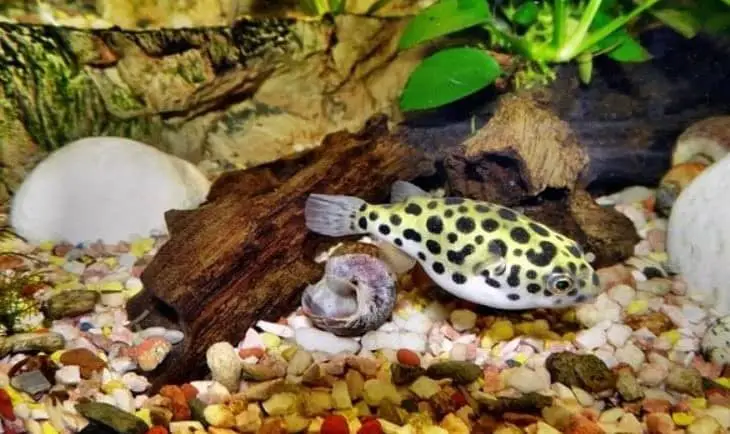
Water Requirements for Freshwater Puffers?
What are the desired pH value and the temperature for balloon fishes?
Often, they need a pH of freshwater which is marked nearly as 7 to 7.6. Yet, a certainsoecus can even live in brackish water which has some acidity. And, the desired temperature may vary from 74°-78 °F as with the species.
Is a filter mandatory to a tank used for puffer fishes?
Yes! The filter may have several actions inside a fish tank. Basically, it can decide the water current up to a desired pattern and level as with the adopting species. Since it filters the water appropriately, you can easily clean out the harmful nitrogen by-products of the water. So, it will minimize water toxicity. Thus, experts suggest adding a filter which has the efficacy to provide dKH up to 8 as the minimum value and 12 as the maximum. Further, if it provides a lighting system, it is nice too.
How should be the freshwater puffer fish tank sizes?
Usually, the size of the tank desired for these puffer fishes may vary as with the condition of how much they can grow longer. So, there are standard tank sizes for different types. Here are the reference values for the commonest types which we have discussed early. Yet, since the given values are appropriate only for a fish, you should keep in mind to increase the sizes if you are adopting more than one fish.
Dwarf Puffer: 10 gallons
Red-Tailed Puffer: 10 gallons
Crested Puffer: 55 gallons
Imitator Puffer: 10 gallons
Fahaka Puffer: 125 gallons
Golden Puffer: 125 gallons
South American puffer: 40 gallons
Congo Puffer: 40 gallons
Mbu Puffer: 500 gallons
Can you put 2 puffer fish together?
Even the experts suggest keeping the puffer fishes alone is the best to prevent aggressive behaviors, there are reported cases of a peaceful companion of two varieties. Yet, do not pair or group the puffer fishes without the guidance of an aquarium specialist.
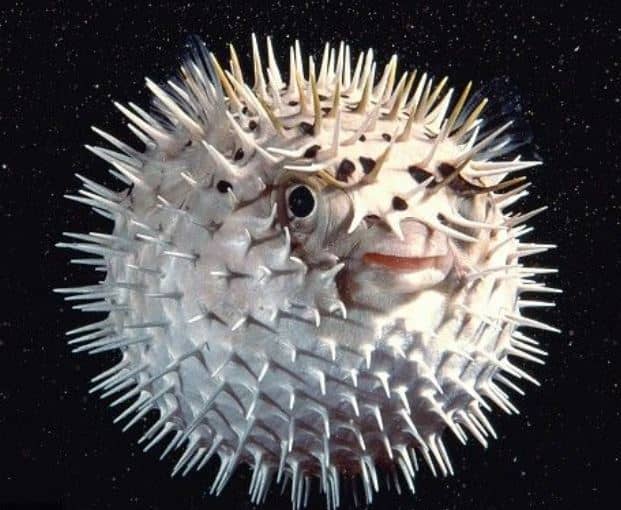
Who are the freshwater puffer fish tank mates?
The puffer fishes show the same aggressive behavior towards other species too. So, the best recommendations are to keep them alone and enjoy aquaculture other than seeing the deaths of loved fishes. If they are kept with other fish large tank sizes may be required with a lot of hiding places.
How to plant and set up your aquarium for puffer fishes?
The varying types of balloon fishes need different conditions. While one type of fishes desires to live in a planted aquarium, the other type may need a layer of sand and soft base to hide when feeling bored. But, they also need enough space to swim here and there when needed.
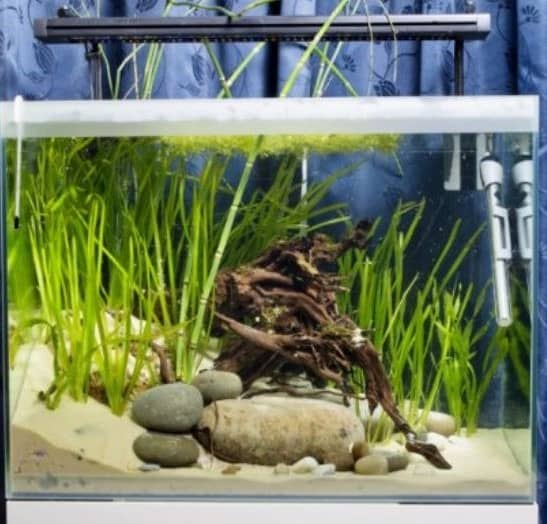
What to Feed Puffer Fish and the perfect frequency of feeds?
These fishes are used to having an omnivorous diet style. So, you may feed them with both plant-based products such as vegetables and meaty substances. And, it says these fishes may eat anything you feed them. But, we suggest you be somewhat careful as they are easily prone to diseases and allergies.
So, the ideal diet for freshwater puffer fish should be a mixture of squids, clams, krill, and frozen vegetable pieces. But, the frequency of feeding veggies and fruits should be maintained under twice a week only. And the average frequency per day is also twice. So, preferably it can be morning and evening feeds.
But, the ideal feeding frequency per week may depend upon the maturity of the fish. It usually measures through their body sizes. And, as a reference, you can follow daily feeds for fishes under six centimeters (2 inches), every other day feeding times for fishes in between two to four inches, and once in two days or three days for fishes over four inch.
Thus, if you are adopting a larger-sized species or matured fishes, you should not need to spend the time for frequent feeds.
At last, you should remember to feed the chopped and defrosted foods to ease off ingestion.
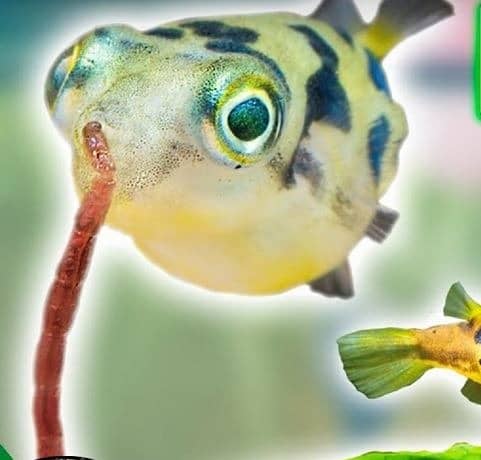
How big does a freshwater puffer fish get?
The body sizes of puffer fishes after maturity may depend upon the species. Thus, generally, it can vary from one to two centimeters to one or two feet. Therefore, the ability to cultivate them inside a domestic aquarium may depend upon the behavior of the type and their body size even after inflating to ball fish.
The lifespan of freshwater puffer fish?
If well cared for they can live up to 10 years in captivity. New larval. And, the larval will get matured and will live almost over 8 years of ten years only if there are no any unfortunates due to common diseases.
Freshwater Puffers’ Breeding
It is easy to breed these balloon fishes only if you are lucky enough to find a paired fish. Otherwise, you will have to face for more significant challenges when pairing. Since they have an aggressive attitude towards other fishes, pairing is the most difficult thing when breeding.
But, since almost all the types showing sexual dimorphism, you may be able to note the dominant male at maturity. Often, males can be identified through brighter skin and color changes. And they are bigger too. So, next, the male will release hormones and the cells to fertile a female egg. Once the females got the signals of hormones released by males, they show spawning behaviors and will see all around the area, which is the male stays. Next, they will release hundreds to thousands of eggs.
These eggs are fertile and will develop up to a new larval. And, the larval will get matured and will live almost over 8 years of ten years only if there are no any unfortunates due to common diseases.
And the next challenge arises when the larval is released through cracked eggs. Often, the puffers used to eat their own larval. But, actually, they care a lot about eggs and will save the eggs nicely. So, you will not expect such bad news. Yet, if you didn’t separate the parents, you will fail in breeding freshwater puffer fishes. Once the eggs are cracked a numerous larval will be released into the water, and they will develop up to a smaller sized fish baby over time.
Often, within a few days to months, they all will reach their maximum maturity as an adult fish. The time taken for this process may vary as with the type and species.
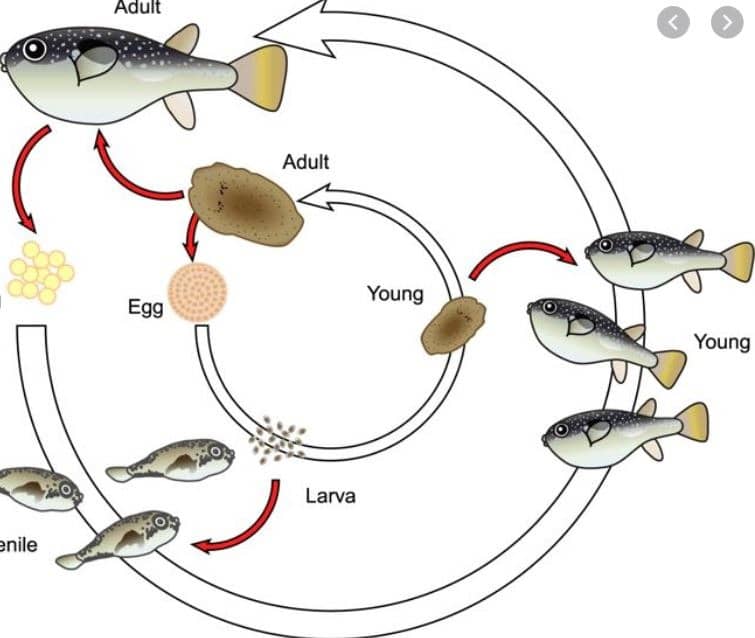
Freshwater Puffer fish Common Illnesses
The freshwater puffer fishes often suffer from parasitic attacks. And, the poor water quality or the poor feedings may cause frequent sicks among puffers. Thus, you should remember to keep checking the water and tank conditions. Frequent cleans, water changing, and observing the newly introducing puffers for possible illnesses are the best ways to prevent these frequent diseases.
And, you may be able to identify possible sicks with fin and skin discolorations. Or else, you will note lethargic behaviors, fewer responses for feedings, and fewer spawning behaviors as the signs of sickness.
Where to buy Freshwater Puffers?
The local fish shops will sell freshwater puffer fishes for domestic use as pets. And, there are even online sales for puffer fishes. Thus, you will wonder to see your tiny fish friend exactly at your doorstep with just one click. But, if you want a puffer fish for commercial use, we suggest you go for a direct seller. Then, they will hand over healthy and perfect fish under your conditions with the care sheets.
Conclusions!
At last, if you be able to set the ideal water and tank conditions for puffers, adopting a freshwater puffer fish in your domestic aquarium may not be a challenge. Yet, it is good to keep in contact with an expert in the field to provide the best conditions for these balloon fishes!
Credits FOR video Aquarium Co-Op
Also, see our guide about Wild Betta
